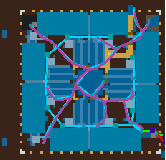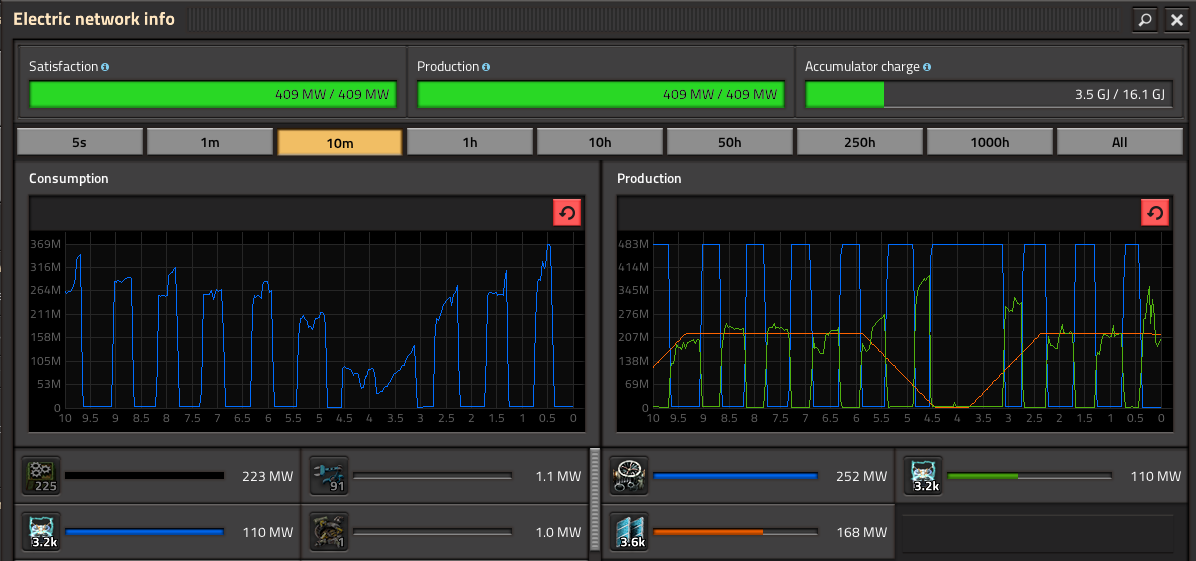It is updated version for Space Age
------------------------------------------------------------------------------------------------------------------------------------
Target
- design the perfect power plant which is best in several points of view - efficiency, build expense and the design beauty
- The blueprint book starts from 1 core power plant which could be upgraded on the same spot up to 4 cores.
- Blueprint reserves the space in advance so you can start small then scale up later.
The Blueprint Book suits for early game by cheap start, also suits late game, as it fits into Megabase city block design (More on Nilaus's Youtube ).
Design incudes documentation of thermal balance, combinators and build expense. You could check why, or how it works, possibly find an improvement. Combinators use description feature.
The Perfect CloverLeaf Book
contains 4 variants to choose from 40 / 160 / 280 / 480 MW . It is designed to be built on top of each other. When more power is needed, press Shift key and left click to place the bigger one over an old.

- It is belt based.
(but blueprint comes with a robo-attachment so its ready to go for bots. However, keep in mind that electrical powered bots can not start electric power plant without electricity.)
- It is friendly for pocket roboport build, there is enough of space to let you walk inside.
- It is saved with landfill, just in case.
- It is compact square 56x56 = 3136 tiles
- Power density is 480 MWe/3136 Tiles=153,1kWe/tile of sustainable output
Water Supply
after Space Age, water supply is an easy task. Flow system is streamlined and water consumption is 1/10th of original. For supplying whole plant, one Shore pump connected by one tubeline is enough. Those two red marked pumps you see on the picture are option, use one of them.
Perfect Activation
It autostarts. Wait till morning or until charge clock counts 200 seconds (upper right combinator area).
Alternatively, you could use ManualOverride for immediate feed. Look for an Static combinator with RedSquare and a description : "MANUAL_OVERRIDE - turn it On and Off again"
Perfect Power Output
83 turbines produce dead straight line 480MW of sustainable output. There is no power drop when new cell(s) is inserted, because the cold interval is reduced to ~ 0 tick (usual game performance is 60 ticks per second).
Perfect Brownout Protection & Lossless
Factorio CheatSheet says that 4 cores loss-less need 40 steam tanks. There is an inconspicuous note down-there saying : "not including heat stored in the reactor or pipes (both heat and steam). "
That note means, you actually need 3 ( y e s, t h r e e
We see ( -2,4 ) steam storages are missing to reach lossless balance. So add 4 steam storages and 4 heatpipes to get extra reserve, and nice design symmetry. In Space Age, all fluid vessels are considered as one object, therefore performance impact adding an extra steam storage is close to none.
Fluid pumps keep turbines under pressure
After Space Age, fluid pumps are removed from design, no longer needed.
Two power grids feature
when you get out of power (for some reason), you can chicken out and eventually re-start a power plant manually feeding fuel cells by hand. However, it would not be the Perfect design, right ?
Combinators
There are three circuitry
Bonus build Fuel cell (re)processing
a compact fuel cell (re)processing facility. It turns on itself only when needed and (re)produce as much fuel cells as needed. Fun to watch.
---------------------------------------------------------------------------------------------------------
******************************************************************************************
Edit: 22.2.2025 Latest Update:
Version 5.3 released
- removed wooden boxes and power polls (wood is too difficult to get on other planets)
- water feeding system is a loop, symmetrical and easy to connect anywhere
- improved incoming fuel contraption
- streamlined belt
- MANUAL OVERRIDE feature has a safety for over-feding
11.2.2025
Version 5.1 released
- contraption for incoming fuel is now more secure. One added inserter for burned cells instead of belt read. In case of power outage or even brownout, it could miscalculate
30.1.2025
Version 5.0 released
- after Space Age, thanks to fluid changes we can cut out some things : 6 fluid pumps, 2 Steam tanks, about 20 pipes
- foot print changes from 56x57 to perfect square 56 x 56
- added Manual Override (static combinator) for immediate feed system activation
The Perfect Clover Leaf book
Because of size, blueprint is added as attachment : 1. download the text file
2. open in notepad, ctrl+A, ctrl+C
3. switch to the game, press import blueprint button, ctrl+V, press OK
4. the power plant book is available in your library
******************************************************************************************
If you've noticed any imperfection, or possible improvement, let me know.
******************************************************************************************



 =1 which activates all the filter inserters to feed reactors, and also it is signal to re-start one time-clock (so fuel cycle countdown is restarted).
=1 which activates all the filter inserters to feed reactors, and also it is signal to re-start one time-clock (so fuel cycle countdown is restarted).

 ) when Energy E< 10%
) when Energy E< 10% ) when Energy E> 80%
) when Energy E> 80%







